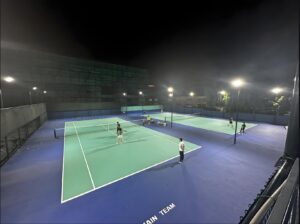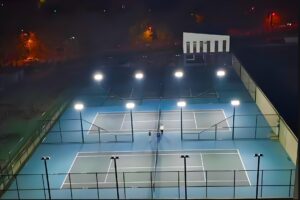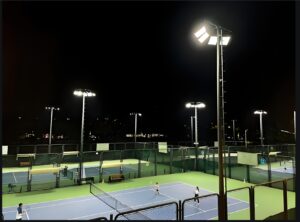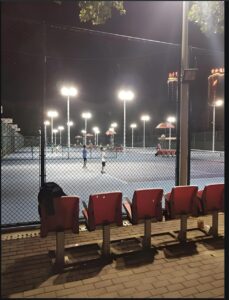5. Lighting Technology for Consistent Brightness and Even Coverage
- LED Lighting Advantages: Modern LED lighting systems provide superior consistency in brightness and color temperature compared to traditional lighting options. LEDs are capable of offering high levels of illumination while maintaining uniformity across the entire court, reducing the risk of hot spots or dim areas. This is achieved through advanced optical designs, such as carefully placed reflectors or lenses that distribute light evenly across the playing surface.
- Customizable Lighting Solutions: LED systems offer a high degree of flexibility, allowing for precise control over light intensity, angle, and distribution. This means that venues can tailor the lighting to the specific needs of a tennis court, ensuring that every part of the court is evenly illuminated. Furthermore, LEDs can be dimmed or adjusted during breaks or non-match hours, providing energy savings without compromising the quality of the lighting when the court is in use.
6. Energy Efficiency without Compromising Brightness
- Maintaining High Performance While Reducing Energy Consumption: While achieving consistent and even lighting is critical for tennis, it is equally important to do so in an energy-efficient manner. Traditional lighting systems often require excessive energy to provide sufficient brightness, leading to high operational costs. LED lighting, however, uses a fraction of the energy required by traditional systems while delivering consistent, high-quality illumination. This makes LEDs a cost-effective choice for sports venues, offering both excellent performance and lower energy consumption.
Consistent brightness and even coverage are critical to ensuring fair play, enhancing player performance, improving broadcast quality, and maintaining player safety in tennis. Uneven lighting or fluctuating brightness can compromise a player’s ability to see the ball clearly, introduce unfair advantages, and negatively impact the spectator experience. LED lighting systems, with their ability to provide uniform, high-quality illumination across the entire court, offer a solution that addresses these concerns. With their energy efficiency, long lifespan, and ability to maintain consistent brightness over time, LEDs are the ideal choice for tennis venues looking to improve the quality of the game while optimizing operational costs. By investing in quality LED lighting, sports venues can ensure that players perform at their best and that fans enjoy a top-tier visual experience both in-person and on screen.

How LEDs provide uniform illumination to eliminate shadows and hot spots
Achieving uniform illumination on a tennis court or any sports venue is essential to ensure fairness, player safety, and optimal viewing experiences. One of the most significant challenges in sports lighting is eliminating shadows and hot spots (areas of intense light) that can disrupt the visibility and performance of players and viewers alike. LED lighting systems, with their advanced technology and design capabilities, excel in providing uniform illumination, making them ideal for sports venues where precision and consistency are paramount. Below, we delve into how LED lighting achieves this uniformity and why it is superior to traditional lighting solutions in eliminating shadows and hot spots.
1. Advanced Optical Design
- Lens and Reflector Systems: One of the main reasons LEDs provide uniform illumination is the use of specially designed lenses and reflectors. These components help distribute light more evenly across the playing surface. Traditional lighting sources often create intense points of light, resulting in hot spots where the light is concentrated and shadowy areas where light does not reach. LEDs, however, use optical lenses and reflectors that carefully control the direction and spread of light, ensuring that it is distributed evenly across the entire area. These systems prevent light from being too intense in some areas and too dim in others, providing a consistent level of illumination throughout the court.
- Asymmetrical Light Distribution: Many LED fixtures are designed with asymmetrical light distribution in mind, meaning the light is directed more efficiently toward the playing surface. This allows for uniform coverage over the court, eliminating the creation of bright spots or dark zones. The ability to control the light’s direction helps in achieving a balanced and uniform light spread, which is essential for reducing glare and ensuring clear visibility for players.
2. Precise Control over Light Output
- Dimmable and Adjustable LEDs: Unlike traditional lighting sources such as metal halide or sodium vapor lights, LEDs offer precise control over the light output. LEDs can be dimmed or adjusted to achieve the desired brightness levels without affecting their overall performance. This flexibility allows sports venues to fine-tune the light distribution to achieve a consistent level of illumination across the court. By adjusting the light levels in real-time, any potential hot spots or areas with inadequate lighting can be corrected quickly, ensuring a smooth and even lighting experience for players and spectators.
- Modular Design for Fine-Tuning: Many modern LED sports lighting systems feature a modular design, where multiple LED units are used together to illuminate large spaces. Each module can be positioned and adjusted to provide a specific angle and light distribution, allowing for highly customizable setups. This modularity ensures that every part of the court is adequately lit, reducing the risk of hot spots or areas with uneven brightness.

3. High Color Uniformity
- Consistent Color Temperature: One of the challenges in achieving uniform illumination with traditional lighting is the variation in color temperature across the venue. This inconsistency can lead to parts of the court appearing brighter or darker in color, which can be distracting for players and viewers. LED lighting, however, provides consistent color temperature across the entire court. With LEDs, the color rendering is uniform, meaning the brightness and color tone remain consistent in every area. This uniformity in color temperature ensures that there are no color discrepancies that could cause uneven illumination or disrupt the visual experience.
- High CRI (Color Rendering Index): LEDs with a high CRI (above 90) can render colors more accurately and evenly, ensuring that the court surface, players, and the ball are illuminated with natural and uniform light. High CRI LEDs eliminate any unnatural color shifts that could occur with other lighting sources, ensuring that all areas of the court are lit evenly, which further enhances the visibility and overall lighting quality.
4. Reduced Glare and Reflections
- Glare Control: Traditional lighting sources, such as halogen or metal halide lamps, can create intense glare that causes discomfort for players and makes it difficult for them to focus on the game. Glare can also affect the audience’s ability to see the action clearly, especially in TV broadcasts. LEDs, however, can be designed with glare-reducing features, such as diffusers or baffles, which soften the light and direct it precisely where it is needed. This minimizes light spilling into unwanted areas, creating a more pleasant and comfortable environment for players and viewers.
- Anti-Reflection Technology: Sports lighting systems using LEDs can also incorporate anti-reflection technology to reduce unwanted reflections off the court surface or nearby objects. This ensures that players have clear sightlines without interference from reflected light. Such features help eliminate the potential for uneven brightness due to reflections from walls, floors, or other surfaces.
5. Directional Lighting and Beam Angle Control
- Precise Beam Angles: LED fixtures often come with adjustable beam angles, which provide further control over light distribution. By adjusting the beam angle, LEDs can be positioned to cast light over specific areas of the court, ensuring even coverage and reducing the potential for uneven illumination. This control over beam angles allows for targeted lighting where it’s needed, eliminating shadows that may be created by traditional lighting systems with broad, uncontrolled light spread.
- Eliminating Spill Light: LED lighting systems can also be designed to focus light more effectively, minimizing spill light outside of the court’s boundaries. This not only ensures that light is concentrated on the court, reducing hot spots but also makes the lighting system more efficient, as less energy is wasted on illuminating areas outside the desired zone.
6. Integration of Advanced Lighting Controls
- Smart Lighting Systems: Many modern LED sports lighting systems include smart control features, which can adjust light intensity, focus, and distribution based on real-time conditions. Using sensors or automated control systems, the lighting can be dynamically adjusted to maintain consistent illumination across the court, even when external conditions such as weather, time of day, or event type change. This adaptability ensures that the lighting system continues to provide uniform brightness and eliminates potential variations in light output that might cause hot spots or shadowy areas.

7. Even Distribution at Different Heights
- Adjustable Mounting for Optimal Coverage: LEDs can be mounted at various heights, and the fixtures themselves can be tilted or rotated to achieve optimal light coverage. This adaptability allows the lighting system to be customized based on the size of the court or the specific requirements of the venue. By adjusting the mounting height and angle of the LED fixtures, the lighting can be distributed evenly across the entire playing surface, further ensuring uniform illumination.
LED lighting systems provide a significant advantage over traditional lighting in achieving uniform illumination and eliminating shadows and hot spots. With advanced optical designs, precise control over light output, glare reduction features, and customizable beam angles, LEDs ensure that every part of the court is evenly lit, providing optimal visibility for players and spectators alike. The ability to fine-tune the lighting in real-time, adjust beam angles, and achieve consistent color temperatures further contributes to a more enjoyable and fair playing environment. Whether for television broadcasts or live audiences, the even distribution of light offered by LED systems enhances the quality of the game, ensuring that no part of the court is left in the dark. As a result, LED lighting is the ideal solution for tennis venues and sports arenas looking to provide top-tier lighting performance.
Instant Lighting and Flicker-Free Operation
Benefits of instant on/off functionality
One of the key advantages of LED lighting systems is their instant on/off functionality, which distinguishes them from traditional lighting sources like halogen or metal halide lamps. This feature brings a range of benefits to sports venues, players, and event organizers, enhancing both operational efficiency and the overall lighting experience. Below, we explore the key benefits of instant on/off functionality in LED sports lighting.
1. Energy Savings and Efficiency
- No Warm-Up Time: Traditional lighting sources such as metal halide lamps require several minutes to warm up before they reach full brightness, and similarly, they also need time to cool down before being turned back on. LED lights, on the other hand, achieve full brightness immediately when switched on. This means there is no energy wasted during warm-up or cool-down phases. The instant on/off functionality allows venues to switch lights on only when necessary, preventing unnecessary power consumption and helping to reduce overall energy costs.
- Reduced Energy Waste: With the ability to switch the lights off instantly after the event or during breaks, energy waste is minimized. For example, during non-match periods or in between sets, LEDs can be turned off immediately without affecting the environment’s light levels when switched back on. This can significantly contribute to energy conservation in sports venues, especially for large outdoor arenas.
2. Operational Flexibility
- Quick Adjustments for Event Scheduling: Sports events, particularly at large venues, can have complex schedules, with multiple activities happening back-to-back. Instant on/off functionality allows for quick adjustments to the lighting system, enabling the venue to turn the lights on or off without delay between events, transitions, or practice sessions. This level of operational flexibility is crucial for managing a wide variety of events, ensuring the lighting is precisely controlled to match the needs of each activity.
- Immediate Lighting Adjustments: If there are any issues with the lighting or if there is a need to temporarily adjust the light intensity (for example, during breaks or maintenance), the ability to instantly turn the lights on or off allows for fast troubleshooting and optimization of the lighting system. This can prevent unnecessary delays and disruptions during events, ensuring smooth operations.
(To Be Continued)



